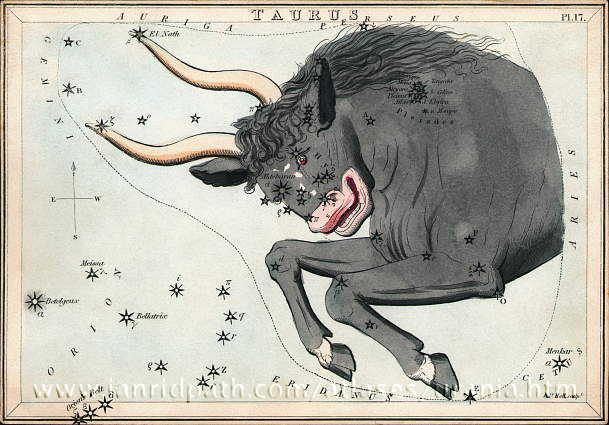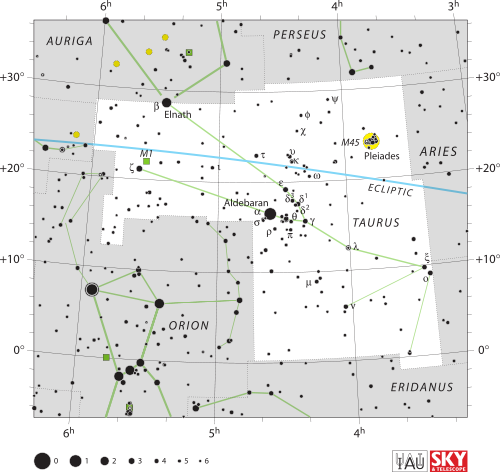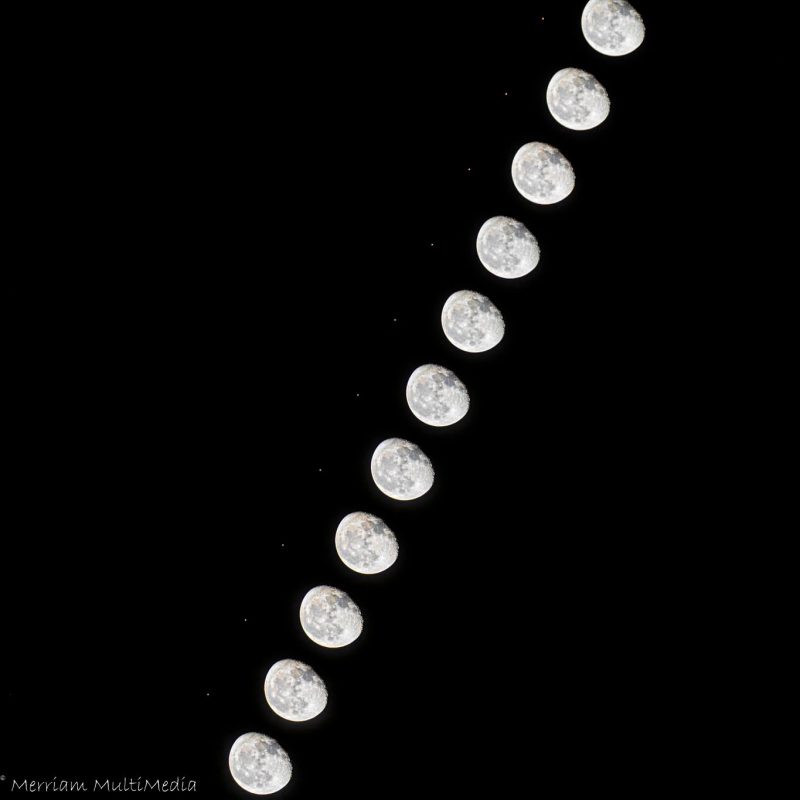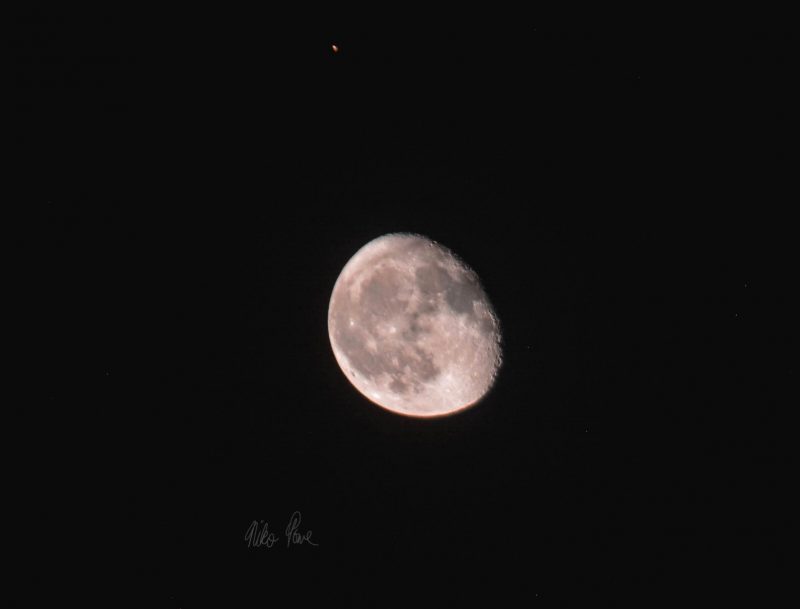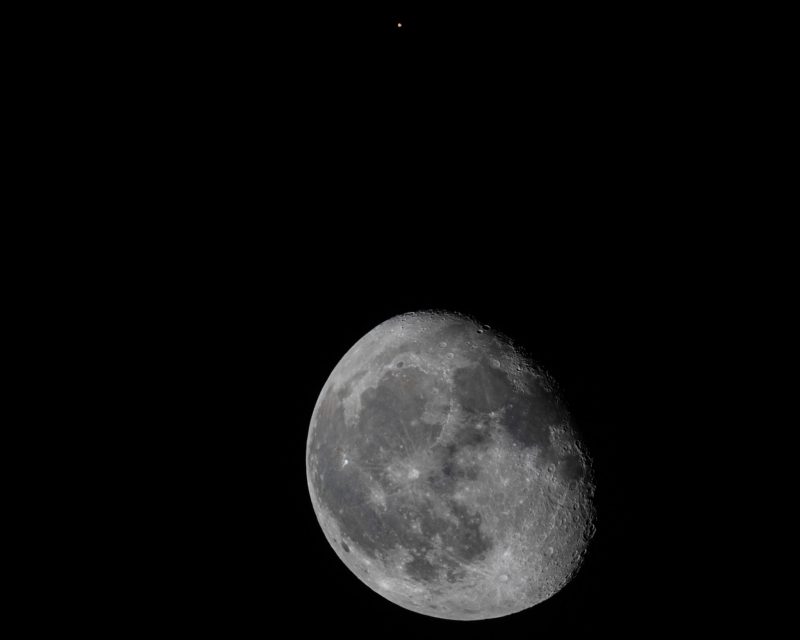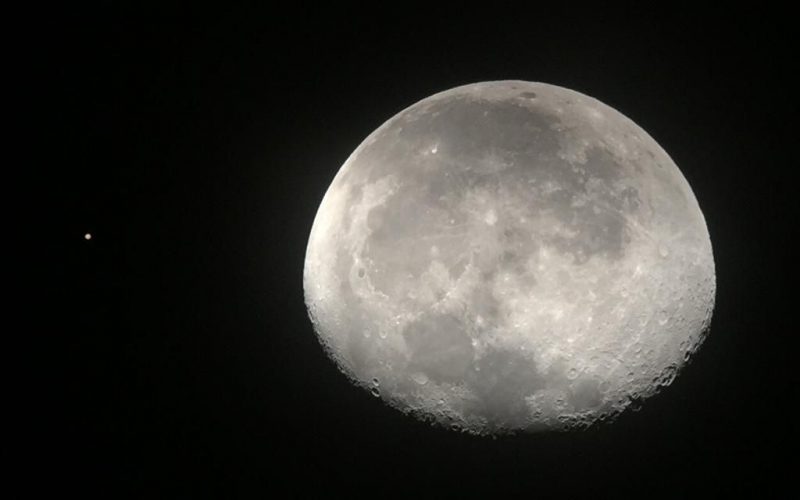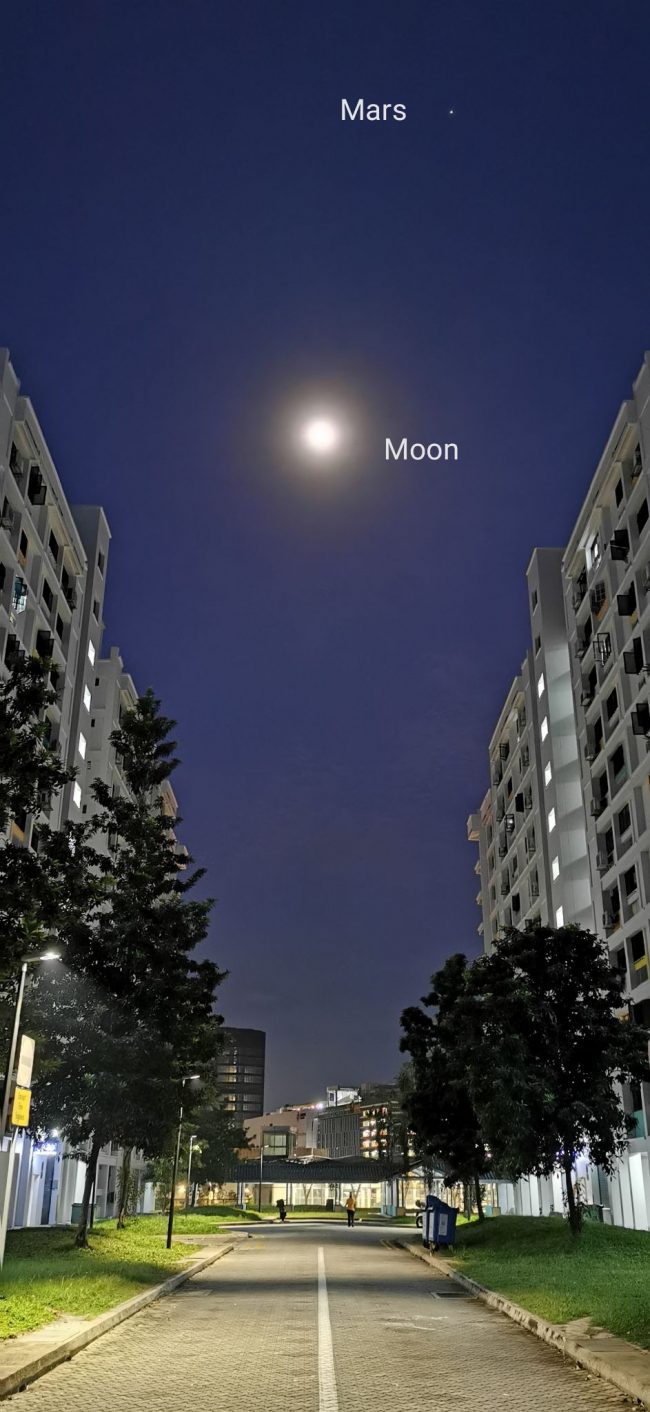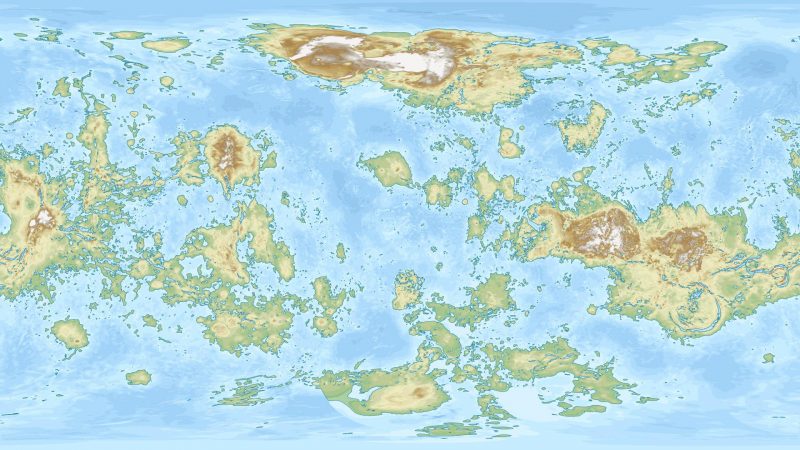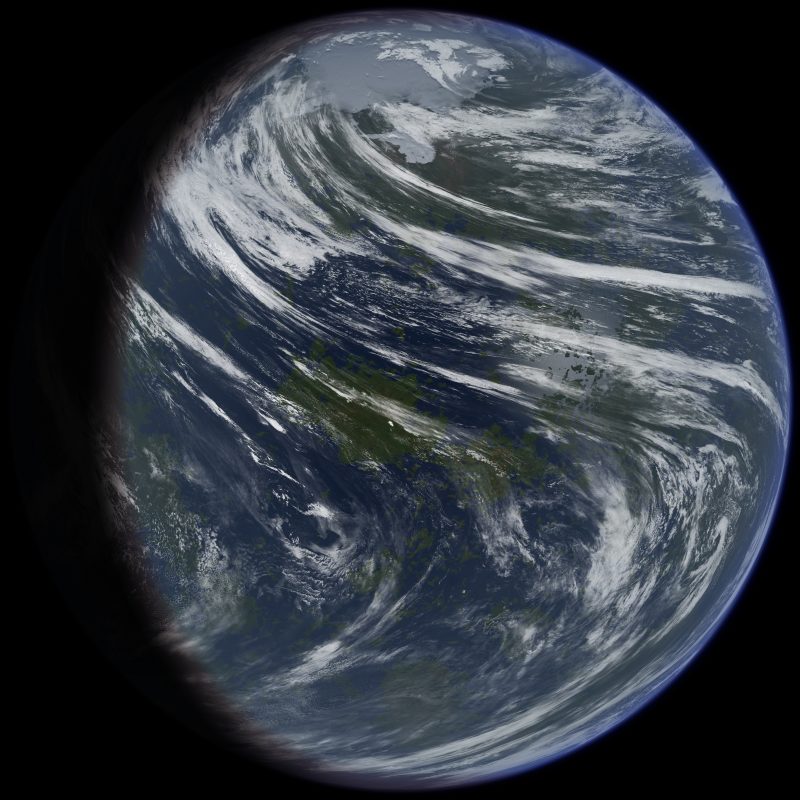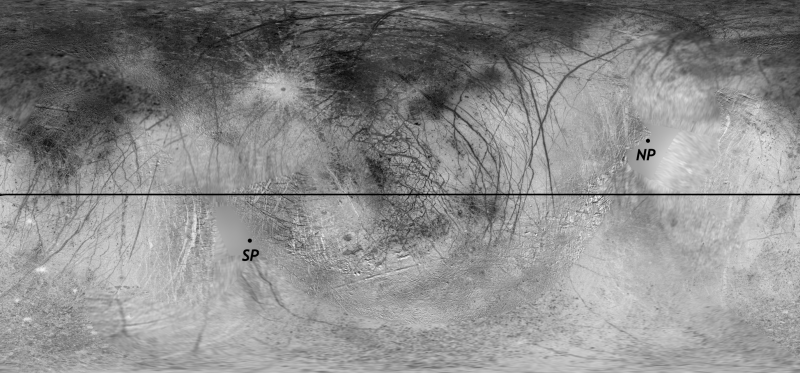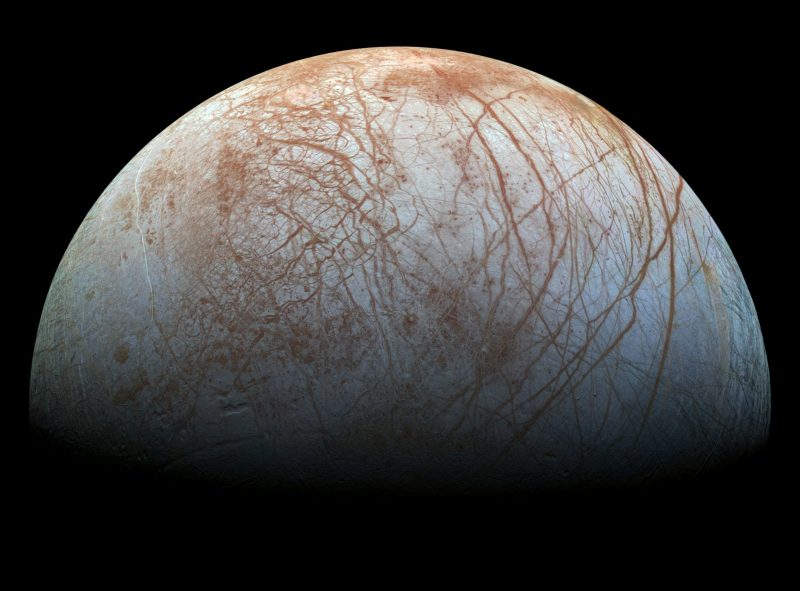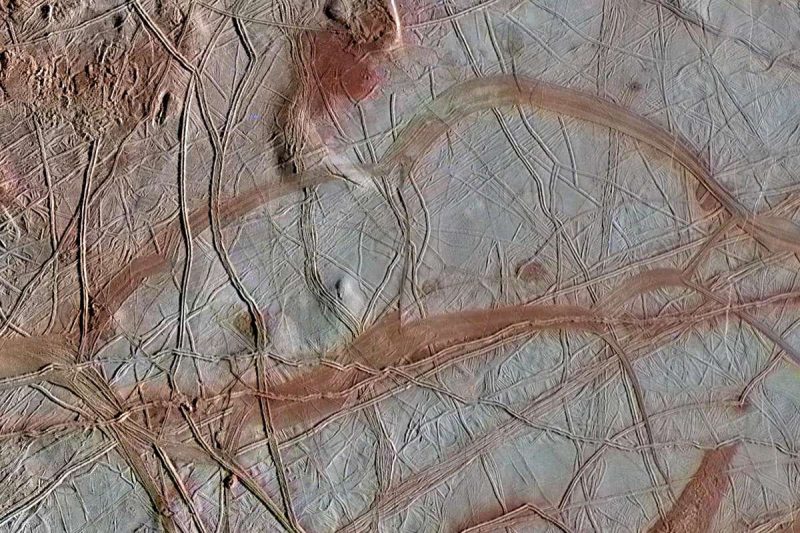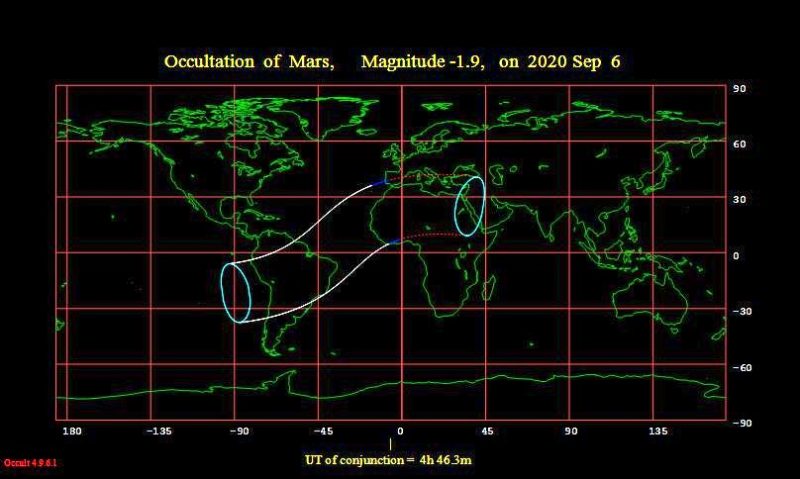

The quality of mass is what separates planets from brown dwarfs from stars. Here’s a general comparison of the masses of each. Image via NASA/ Caltech/ R. Hurt (IPAC).
The amount of mass a star is born with is what determines its fate. Stars are objects born with large masses – and therefore strong self-gravity – so that the star squeezes in on itself, creating high internal temperatures. The high temperatures spark thermonuclear fusion reactions, which enable stars to shine. Planets, on the other hand, have much smaller masses, weaker gravity and no internal fusion; they shine mainly with light reflected from their stars. Brown dwarfs fall somewhere between the masses of giant planets like Saturn and Jupiter, and the smallest stars.
We could speak of brown dwarf masses as fractions of our sun’s mass, but astronomers typically use Jupiter’s mass as a standard measure. A value of 13 Jupiter-masses is considered to be the upper limit for large gas giant planets. Greater than 13 Jupiter-masses, and a simple form of thermonuclear burning (fusing) can occur in the object’s interior – the fusing of deuterium – a rare element leftover from the Big Bang. A value of greater than 80 Jupiter-masses is the lower limit for burning normal hydrogen – the process by which stars are able to shine – and therefore for enabling an object to qualify as a fully-fledged star.
Thus, for convenience and ease of visualization, a brown dwarf is typically defined as any body lying in the range of 13 and 80 Jupiter-masses.
But there’s a lot more to this story …

View larger. | Brown dwarfs are part of the menagerie of objects found in outer space. This image shows the central portion of the Orion Nebula, a relatively nearby star-forming region in our own Milky Way galaxy. The image shows an area measuring roughly 4 by 3 light-years. Each symbol identifies a pair of objects, seen as a single dot of light in the symbol’s center. The thicker inner circle represents the primary body, and the thinner outer circle indicates the companion. Red indicates a planet; orange a brown dwarf; and yellow a star. Adjacent to each symbol is a pair of Hubble images. The picture on the left is the original image of the primary and companion. The image on the left shows the companion only, with the primary object digitally subtracted through a special image processing technique that separates the images of the objects into binary pairs. Image via HubbleSite.
What is a star?
A star is a large collection of dust and gas that has condensed from a primordial cloud that was disturbed in some way. Various mechanisms can cause the disturbance. For example, the shock wave from a distant supernova – or exploding star – might disturb a primordial cloud in space, centuries or millennia later and many light-years away. The cloud loses its uniformity, and areas with slightly higher density (and thus more gravity) start to attract lighter molecules.
As matter falls into a dense patch in the cloud, it eventually reaches a critical mass; the star starts to fuse deuterium with regular hydrogen, making helium-3 molecules. This occurs at a low temperature (slightly less than 1,000,000 degrees Kelvin or 1,800,000 Fahrenheit).
At the point where fusion begins, we can describe a star differently. Now the star is an object in perfect balance (however temporarily) between the outward-pushing force caused by the fusion reactions in its core, and inward-pushing force of its own self-gravity. Gravity wants to crush a star further, but fusion prevents that from happening. Fusion wants to expand the star, but gravity won’t let it. The result is a fine balance: a star.
If deuterium fusion didn’t take place there would be very few stars in the universe with more than three times the mass of our sun. That’s because – if hydrogen fusion started as soon as the mass and temperature were high enough – the star wouldn’t yet have enough mass for its own self-gravity to resist the outward-pushing pressure of the hydrogen fusion reactions. The star would expand, and this expansion would cause its internal temperature to drop, thus slowing and ultimately ending the hydrogen fusion reactions stars require in order to shine.
Deuterium fusion keeps a star cold enough to allow time for the star to accumulate sufficient mass so that when hydrogen fusion actually starts (around 13,000,000 degrees K or 23,000,000 F), it can continue. By that time, the star is dense enough to have enough self-gravity to resist expansion, so that temperatures stay high in its interior.
Read more: What makes stars shine?
In most cases, you are left with a single major accretion that forms a hydrogen-fusion powered star. It is also possible that in dense clouds a second (binary), third (trinary), or fourth (quaternary) star can evolve. Indeed, there are examples of very complex systems with five, six, and seven stars, called quintenary, sextenary, and septenary, respectively (click each number for examples). These can fall into orbits around each other that (although complex) can still be stable enough to allow planetary formation.
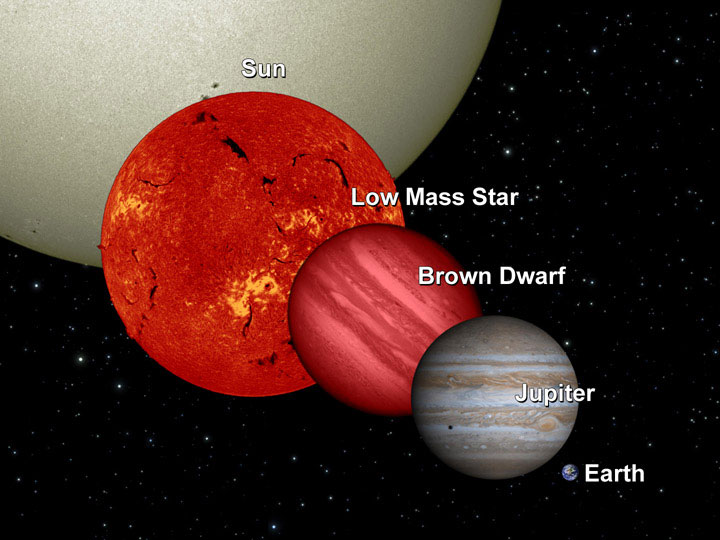
General size comparison between a low mass star, a brown dwarf, and the planet Jupiter. In this image the brown dwarf is shown to be about 15% larger than Jupiter. Image via Wikimedia Commons.
What is a planet?
After stellar formation and the beginning of hydrogen fusion, a solar wind spawns and sweeps the remaining gas out of the system. There will be several minor accretions too bulky to be pushed away by the outward pressure of the solar wind. They will, in fact, fall inward, towards the star.
Since everything in the universe has angular momentum – in other words, since the cloud is rotating or spinning – particles in the initial cloud collecting to form the star will have a tendency to fall in toward the star in a long spiral path. This increases their fall time and thus angular speed, which is why planets end up themselves rotating (spinning) and orbiting their stars generally all in the same direction.
Due to collisions and mutual attractions altering the orbits of the newly forming protoplanets, many will reach an equilibrium point and settle into a stable orbit. These will eventually become true planets – either rocky worlds like Earth or Mars, or gas giants like Jupiter or Saturn – by accreting the remaining small leftovers of the original primordial cloud via their own gravity.

Planets are objects with much less mass than stars. Here’s an artist’s concept, showing a comparison of 3 exoplanets in the Kepler-51 system with some of the planets in our own solar system. Image via NASA/ ESA/ STScI/ CU Boulder Today.
What’s the difference between stars and planets?
Stars form from the collapse of gas and dust in a primordial cloud. Consequently, they have a relatively low amount of what astronomers call metals (to astronomers, metallicity refers to any element heavier than hydrogen and helium). Stars usually travel on their own or as part of a loose group of similar objects. They are massive enough to spark hydrogen fusion in their cores.
Planets form by accreting leftovers in the primordial cloud, after the star has collected up the majority of gaseous material. Planets form with much, much less mass than stars, and thus have much weaker gravity. The lighter elements like hydrogen and helium – so common in stars – tend to escape a planet’s weaker gravitational pull. Thus – relative to stars – planets have high metal content. Planets typically orbit stars. By astronomers’ most recent definition of the word planet, they clear their own orbits of debris.
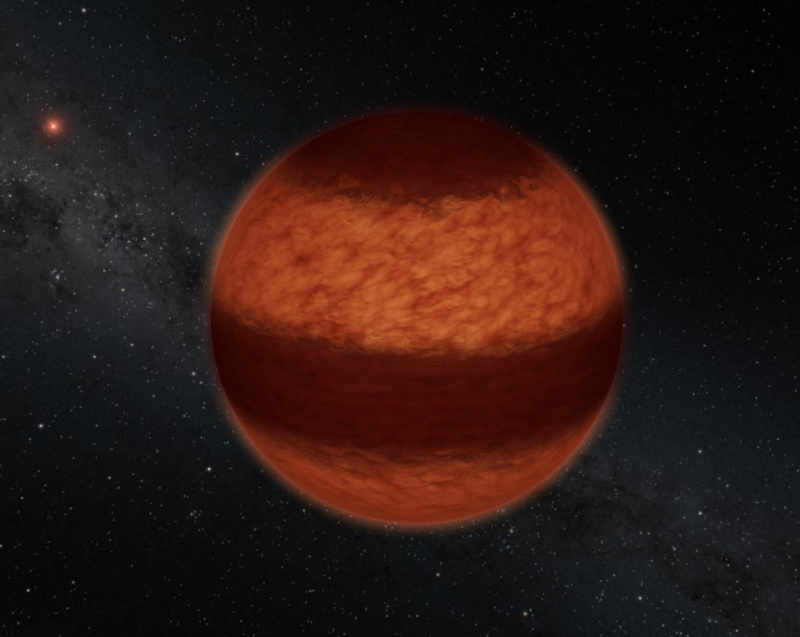
Of course, we don’t really know what brown dwarfs look like. They’re far away, and we’ve never seen one up close. But here’s an artist’s concept of the brown dwarf called Luhman 16A, basd on recent evidence of Jupiter-like bands on its surface. Image via Caltech/ R. Hurt (IPAC).
Where does that leave brown dwarfs?
Brown dwarfs accumulate material like a star, not like a planet. They condense from a gaseous cloud – and are higher in mass than planets and so have stronger gravity – and thus they hold onto their lighter elements (hydrogen and helium) more effectively than planets and so have a relatively low metal content. Their only failing is that they didn’t collect enough material to begin hydrogen fusion, though they can sustain deuterium fusion until the deuterium is gone, which is actually essential to stellar formation with larger masses, as explained earlier.
Brown dwarfs have been found orbiting other suns at distances of 1,000 astronomical units (AU) or more. One AU = one Earth-sun distance. Not all brown dwarfs orbit far from their stars, however; some have been found orbiting at closer distances, and a few rogue brown dwarfs have been spotted, not orbiting any star, although, of course, these are tough to find!
By contrast, of the known planets in our own solar system, Neptune is the major planet orbiting farthest from our sun at 30 AU.
So brown dwarfs are not planets, and they are failed stars, not massive enough to power hydrogen fusion reactions. Thus they get their own classification.
Why brown?
What we now call brown dwarfs were first proposed to exist in the 1960s by astronomer Shiv S. Kumar, who originally called these objects black dwarfs. He pictured them as dark substellar objects floating freely in space that were not massive enough to sustain hydrogen fusion. The name brown dwarf name was later coined by astronomer and SETI researcher Jill Tarter in her Ph.D. dissertation. She was looking to define an upper limit to the maximum mass an object could possess before beginning hydrogen fusion, and thus becoming a full-fledged star.
Stars are clearly not “brown” and many such objects are in the temperature range of 300 to 500 Kelvin (80 to 440 F, or body temperature for a human being and upwards), so they only radiate in the infrared portion of the electromagnetic spectrum. Since black dwarf was already taken as describing objects at the end point in stellar evolution – and red dwarf also had a role to fulfill, as the name for small, cool stars – brown must have seemed an appropriate compromise.
Bottom line: Brown dwarfs are distinct enough to qualify for their own classification. They can be found orbiting fully fledged stars, or other brown dwarfs, or not orbiting any stars. Brown dwarfs must have a certain mass. For convenience and ease of visualization, a brown dwarf is typically defined as any body lying in the range of greater than 13 and less than 80 Jupiter-masses. Now you know!
from EarthSky https://ift.tt/3lPAFrI


The quality of mass is what separates planets from brown dwarfs from stars. Here’s a general comparison of the masses of each. Image via NASA/ Caltech/ R. Hurt (IPAC).
The amount of mass a star is born with is what determines its fate. Stars are objects born with large masses – and therefore strong self-gravity – so that the star squeezes in on itself, creating high internal temperatures. The high temperatures spark thermonuclear fusion reactions, which enable stars to shine. Planets, on the other hand, have much smaller masses, weaker gravity and no internal fusion; they shine mainly with light reflected from their stars. Brown dwarfs fall somewhere between the masses of giant planets like Saturn and Jupiter, and the smallest stars.
We could speak of brown dwarf masses as fractions of our sun’s mass, but astronomers typically use Jupiter’s mass as a standard measure. A value of 13 Jupiter-masses is considered to be the upper limit for large gas giant planets. Greater than 13 Jupiter-masses, and a simple form of thermonuclear burning (fusing) can occur in the object’s interior – the fusing of deuterium – a rare element leftover from the Big Bang. A value of greater than 80 Jupiter-masses is the lower limit for burning normal hydrogen – the process by which stars are able to shine – and therefore for enabling an object to qualify as a fully-fledged star.
Thus, for convenience and ease of visualization, a brown dwarf is typically defined as any body lying in the range of 13 and 80 Jupiter-masses.
But there’s a lot more to this story …

View larger. | Brown dwarfs are part of the menagerie of objects found in outer space. This image shows the central portion of the Orion Nebula, a relatively nearby star-forming region in our own Milky Way galaxy. The image shows an area measuring roughly 4 by 3 light-years. Each symbol identifies a pair of objects, seen as a single dot of light in the symbol’s center. The thicker inner circle represents the primary body, and the thinner outer circle indicates the companion. Red indicates a planet; orange a brown dwarf; and yellow a star. Adjacent to each symbol is a pair of Hubble images. The picture on the left is the original image of the primary and companion. The image on the left shows the companion only, with the primary object digitally subtracted through a special image processing technique that separates the images of the objects into binary pairs. Image via HubbleSite.
What is a star?
A star is a large collection of dust and gas that has condensed from a primordial cloud that was disturbed in some way. Various mechanisms can cause the disturbance. For example, the shock wave from a distant supernova – or exploding star – might disturb a primordial cloud in space, centuries or millennia later and many light-years away. The cloud loses its uniformity, and areas with slightly higher density (and thus more gravity) start to attract lighter molecules.
As matter falls into a dense patch in the cloud, it eventually reaches a critical mass; the star starts to fuse deuterium with regular hydrogen, making helium-3 molecules. This occurs at a low temperature (slightly less than 1,000,000 degrees Kelvin or 1,800,000 Fahrenheit).
At the point where fusion begins, we can describe a star differently. Now the star is an object in perfect balance (however temporarily) between the outward-pushing force caused by the fusion reactions in its core, and inward-pushing force of its own self-gravity. Gravity wants to crush a star further, but fusion prevents that from happening. Fusion wants to expand the star, but gravity won’t let it. The result is a fine balance: a star.
If deuterium fusion didn’t take place there would be very few stars in the universe with more than three times the mass of our sun. That’s because – if hydrogen fusion started as soon as the mass and temperature were high enough – the star wouldn’t yet have enough mass for its own self-gravity to resist the outward-pushing pressure of the hydrogen fusion reactions. The star would expand, and this expansion would cause its internal temperature to drop, thus slowing and ultimately ending the hydrogen fusion reactions stars require in order to shine.
Deuterium fusion keeps a star cold enough to allow time for the star to accumulate sufficient mass so that when hydrogen fusion actually starts (around 13,000,000 degrees K or 23,000,000 F), it can continue. By that time, the star is dense enough to have enough self-gravity to resist expansion, so that temperatures stay high in its interior.
Read more: What makes stars shine?
In most cases, you are left with a single major accretion that forms a hydrogen-fusion powered star. It is also possible that in dense clouds a second (binary), third (trinary), or fourth (quaternary) star can evolve. Indeed, there are examples of very complex systems with five, six, and seven stars, called quintenary, sextenary, and septenary, respectively (click each number for examples). These can fall into orbits around each other that (although complex) can still be stable enough to allow planetary formation.

General size comparison between a low mass star, a brown dwarf, and the planet Jupiter. In this image the brown dwarf is shown to be about 15% larger than Jupiter. Image via Wikimedia Commons.
What is a planet?
After stellar formation and the beginning of hydrogen fusion, a solar wind spawns and sweeps the remaining gas out of the system. There will be several minor accretions too bulky to be pushed away by the outward pressure of the solar wind. They will, in fact, fall inward, towards the star.
Since everything in the universe has angular momentum – in other words, since the cloud is rotating or spinning – particles in the initial cloud collecting to form the star will have a tendency to fall in toward the star in a long spiral path. This increases their fall time and thus angular speed, which is why planets end up themselves rotating (spinning) and orbiting their stars generally all in the same direction.
Due to collisions and mutual attractions altering the orbits of the newly forming protoplanets, many will reach an equilibrium point and settle into a stable orbit. These will eventually become true planets – either rocky worlds like Earth or Mars, or gas giants like Jupiter or Saturn – by accreting the remaining small leftovers of the original primordial cloud via their own gravity.

Planets are objects with much less mass than stars. Here’s an artist’s concept, showing a comparison of 3 exoplanets in the Kepler-51 system with some of the planets in our own solar system. Image via NASA/ ESA/ STScI/ CU Boulder Today.
What’s the difference between stars and planets?
Stars form from the collapse of gas and dust in a primordial cloud. Consequently, they have a relatively low amount of what astronomers call metals (to astronomers, metallicity refers to any element heavier than hydrogen and helium). Stars usually travel on their own or as part of a loose group of similar objects. They are massive enough to spark hydrogen fusion in their cores.
Planets form by accreting leftovers in the primordial cloud, after the star has collected up the majority of gaseous material. Planets form with much, much less mass than stars, and thus have much weaker gravity. The lighter elements like hydrogen and helium – so common in stars – tend to escape a planet’s weaker gravitational pull. Thus – relative to stars – planets have high metal content. Planets typically orbit stars. By astronomers’ most recent definition of the word planet, they clear their own orbits of debris.

Of course, we don’t really know what brown dwarfs look like. They’re far away, and we’ve never seen one up close. But here’s an artist’s concept of the brown dwarf called Luhman 16A, basd on recent evidence of Jupiter-like bands on its surface. Image via Caltech/ R. Hurt (IPAC).
Where does that leave brown dwarfs?
Brown dwarfs accumulate material like a star, not like a planet. They condense from a gaseous cloud – and are higher in mass than planets and so have stronger gravity – and thus they hold onto their lighter elements (hydrogen and helium) more effectively than planets and so have a relatively low metal content. Their only failing is that they didn’t collect enough material to begin hydrogen fusion, though they can sustain deuterium fusion until the deuterium is gone, which is actually essential to stellar formation with larger masses, as explained earlier.
Brown dwarfs have been found orbiting other suns at distances of 1,000 astronomical units (AU) or more. One AU = one Earth-sun distance. Not all brown dwarfs orbit far from their stars, however; some have been found orbiting at closer distances, and a few rogue brown dwarfs have been spotted, not orbiting any star, although, of course, these are tough to find!
By contrast, of the known planets in our own solar system, Neptune is the major planet orbiting farthest from our sun at 30 AU.
So brown dwarfs are not planets, and they are failed stars, not massive enough to power hydrogen fusion reactions. Thus they get their own classification.
Why brown?
What we now call brown dwarfs were first proposed to exist in the 1960s by astronomer Shiv S. Kumar, who originally called these objects black dwarfs. He pictured them as dark substellar objects floating freely in space that were not massive enough to sustain hydrogen fusion. The name brown dwarf name was later coined by astronomer and SETI researcher Jill Tarter in her Ph.D. dissertation. She was looking to define an upper limit to the maximum mass an object could possess before beginning hydrogen fusion, and thus becoming a full-fledged star.
Stars are clearly not “brown” and many such objects are in the temperature range of 300 to 500 Kelvin (80 to 440 F, or body temperature for a human being and upwards), so they only radiate in the infrared portion of the electromagnetic spectrum. Since black dwarf was already taken as describing objects at the end point in stellar evolution – and red dwarf also had a role to fulfill, as the name for small, cool stars – brown must have seemed an appropriate compromise.
Bottom line: Brown dwarfs are distinct enough to qualify for their own classification. They can be found orbiting fully fledged stars, or other brown dwarfs, or not orbiting any stars. Brown dwarfs must have a certain mass. For convenience and ease of visualization, a brown dwarf is typically defined as any body lying in the range of greater than 13 and less than 80 Jupiter-masses. Now you know!
from EarthSky https://ift.tt/3lPAFrI



